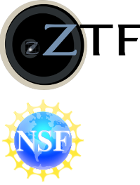ZTF Public Data Release 12
The Zwicky Transient Facility (ZTF) and IPAC at the California Institute of Technology announce the twelveth ZTF Public Data Release. This release adds 2 months of observations to the eleventh data release, up to 7 May 2022 for the public portion of the survey, and private survey time prior to 4 January 2021. The products include ~39.6 million single-exposure images, ~165,500 co-added images, accompanying source catalog files containing ~645 billion source detections extracted from those images, and 4.3 billion light curves constructed from the single-exposure extractions.
Science Highlights
ZTF captures a possible candidate of a high-energy neutrino for a second time
Simeon Reusch et al.; Physical Review Letters, 2022
Press Release
Discovery of two polars with optical and X-ray crossmatch
A team of astronomers have conducted a crossmatch between the newly release eFEDS X-ray catalog (from the eROSITA mission) and ZTF photometry data to look for magnetic cataclysmic variables. They conducted high-cadence optical photometry and phase-resolved spectroscopy on the two magnetic CV candidate they discovered and found them both to be polars.
Large superfast rotators discovered by ZTF
Two high-cadence, large-field ZTF surveys were conducted in 2019 to look for large superfast rotators - a class of interesting asteroids whose fast rotation should destroy them, yet it doesn't. This news study looked closely at the 25 newly discovered superfast rotators in the ZTF data aiming to shed more light on the physical processes that govern them.
Multi-wavelength analysis of the tidal disruption event AT2021ehb
Astronomers describe the nearby (~78 Mpc) tidal disruption event (TDE) after an extensive analysis of the X-ray, UV, optical, and radio follow-up data. The proposed interpretation suggests that the TDE has a magnetically dominated corona and is highly aspherical.
ZTF Faces
Shreya Anand
(Caltech, USA)
I am from West Orange, NJ. I got my B.S. in both Physics and Astronomy (senior thesis with Dr. Leo Singer) at the University of Maryland, and then did research for a semester at IUCAA (Pune, India). I joined Caltech as a PhD student in 2018 and have been here since.
Read OnTony Rodriquez
(Caltech, USA)
I come from Salinas, California, which is a small agricultural town on the Central Coast of California. The town is predominantly (over 75%) Hispanic, with many first- and second-generation immigrants from Mexico, like my parents, having come to work in agriculture.
Read OnScience with public ZTF data
We highlight scientific publications from individuals and groups outside of the ZTF partnership that use ZTF public data
Searching for the Next Galactic Luminous Red Nova
Luminous red novae (LRNe) are astrophysical transients believed to be caused by the partial ejection of a binary star's common envelope (CE) and the merger of its components. In agreement with observations, theoretical studies have shown that outflows from the pre-CE phase produce a detectable brightening of the progenitor system a few years before the ejection event. Based on these assumptions, we present a method to identify Galactic LRNe precursors, the resulting precursor candidates, and our follow-up analysis to uncover their nature. We begin by constructing a sample of progenitor systems, i.e. Hertzsprung gap stars, by statistically modelling the density of a colour magnitude diagram formed from "well behaved" Gaia DR2 sources. Their time-domain evolution from the Zwicky Transient Facility (ZTF) survey is used to search for slowly brightening events, as pre-CE precursor candidates. The nature of the resulting candidates is further investigated using archival data and our own spectroscopic follow-up. Overall, we constructed a sample of ∼5.4×104 progenitor sources, from which 21 were identified as candidate LRNe precursors. Further analysis revealed 16 of our candidates to be Hα emitters, with their spectra often suggesting hotter (albeit moderately extincted) A-type or B-type stars. Because of their long-term variability in optical and mid-infrared wavelengths, we propose that many of our candidates are mass-transferring binaries with compact companions surrounded by dusty circumstellar disks or alternatively magnetically active stellar merger remnants.
--Excerpt from the abstract
'How-to' Guide
New ZTF observing log
Caltech IPAC that manages the ZTF survey data have now compiled an observing log, recording known updates and issues during the survey. The log is JSON formatted to be both human and machine readable as required. The log is now available on IRSA and the it will be updated weekly. Catech IPAC is interested to hear your feedback on the log format and additional entries found by the community. You can send it to the IRSA helpdesk.
View ZTF Observing LogOutreach
Native American band gives a name to an asteroid at the Palomar Observatory
Members of the Pauma band native American tribe, whose ancestral lands include the Palomar mountain, gathered at the Palomar Observatory to name a unique asteroid discovered back in 2020 by ZTF. "Ayló'chaxnim" or "Venus Girl" is the first asteroid to be found that circles entirely within the orbit of Venus.
Read more
Meet our undergraduate summer students
Every summer, the ZTF project welcomes undergraduate students who work on diverse projects across our partner institutions. Mentored by astronomers from the ZTF collaboration, these students learn about independent research and contribute to our understanding of the dymanic universe. Click on the button below to see who they are and what inspires them to pursue astronomy research.
Read MoreZTF is supported by the National Science Foundation and a collaboration including Caltech, IPAC, the
Weizmann Institute for Science, the Oskar Klein Center at Stockholm University, the University of
Maryland, Deutsches Elektronen-Synchrotron and Humboldt University, Lawrence Livermore National
Laboratory, the TANGO Consortium of Taiwan, the University of Wisconsin at Milwaukee, Trinity College
Dublin, IN2P3, University of Warwick, Ruhr University Bochum, and Northwestern University . Operations are conducted
by COO, IPAC and University of Washington.
Any opinions, findings, and conclusions or recommendations expressed in this material are those of the
author(s) and do not necessarily reflect the views of the National Science Foundation.









